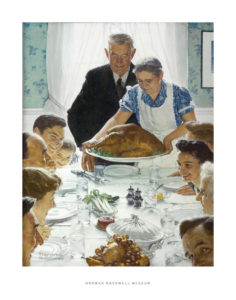

Thanksgiving isn’t just about Native Americans, turkeys and watching football. In fact, turkey was not even served at the first Thanksgiving dinner. According to Charles C. Mann in his book, 1491: New Revelations of the Americas Before Columbus, the first meeting between the Pilgrims and the natives was a public relations affair.
John Carver, the first governor of the Massachusetts colony, and Massasoit, leader of the Wampanoag Nation, negotiated a treaty. In it, the Wampanoag Nation agreed to allow the Pilgrims to stay there and to protect them from any enemies if the Pilgrims would provide protection for Massasoit’s people.
The treaty was of utmost importance to both parties. The population of the Wampanoag Nation had been drastically reduced by smallpox and they feared being overrun by enemy neighbors. They considered the Europeans fools because they didn’t know how to obtain food in what the natives saw as a land of plenty. But they had guns, which the Wampanoag’s enemies feared.
“Turkey was not even served at the first Thanksgiving dinner.”
The meeting lasted three days. The menu would have featured venison, ducks, geese, oysters, lobsters, eel and fish. They also probably ate corn, cranberries and pumpkin (but no pumpkin pie).
From Harvest Festival to National Holiday

The celebration has changed a lot over its nearly four-hundred-year history. It didn’t even become a national holiday until over 200 years later. Sarah Josepha Hale, who wrote the song “Mary Had a Little Lamb,” campaigned to have it made a national holiday for seventeen years. Finally, on October 3, 1863, President Lincoln proclaimed Thanksgiving an official holiday.
President Lincoln established the fourth Thursday of November as Thanksgiving Day. In 1939, President Roosevelt moved it up a week in an attempt to lengthen the Christmas shopping season to ease the Depression. The move proved unpopular. Two years later it was moved back to the original date.
Let’s Talk Turkey
Americans gather on Thanksgiving Day to give thanks with families and friends. They typically feast on traditional holiday foods – turkey and trimmings – and watch football and parades. Practices vary, however, in different parts of the country. For example, in the way they cook the turkey. In most states it is smoked. People in Pennsylvania, Wisconsin, Hawaii and the New England states roast theirs. In California, Nevada, New York, Louisiana and most southeastern states, frying is the preferred method. In most places pumpkin is the traditional pie. But in New York, New Jersey, Delaware and New England, it is apple, while people in Alabama, Mississippi and Louisiana prefer pecan pie.

And speaking of turkeys, Benjamin Franklin considered the wild turkey a more appropriate symbol for the newly independent United States than the carrion-eating bald eagle, which had already been selected by the Continental Congress. The wild turkey differs dramatically from the sluggish domesticated bird, which had not yet been bred. Franklin considered this swift, wily native “a much more respectable Bird” to represent the American people, “a Bird of Courage.”
Turkey is generally considered a healthier food than red meat. Since it is high in tryptophan it is popularly believed to cause sleepiness after a meal. According to Live Science News this is a misconception. The foods containing carbohydrates, fats and alcohol accompanying the turkey dinner are the more likely culprit.
Putting the Turkey on the Table
It probably comes as no surprise that the cost of Thanksgiving dinners has risen over the last twenty years. Quartz Media has devised the TURKEY (Thanksgiving Underlying Rate of Key Yardsticks) Inflation IndexTM. It tracks the rise in cost of pertinent food items based on data from the CPI assembled by the Bureau of Labor Statistics back to 1998. The TURKEY Index has risen 47% since 1998. The main driving factor is the humble potato. It increased 85% in cost during that time. The item that increased the least is wine at home, which went up only 14%.

On the other hand, the American Farm Bureau’s Director of Market Intelligence, Dr. John Newton, said of 2017’s Thanksgiving feast, “For the second consecutive year, the overall cost of Thanksgiving dinner has declined. Even as America’s family farmers and ranchers continue to face economic challenges, they remain committed to providing a safe, abundant and affordable food supply for consumers at Thanksgiving and throughout the year.”
The American Farm Bureau’s annual survey showed that the 2017 cost of a Thanksgiving feast for 10 people went down by 75 cents over the past year, from $49.87 to $49.12. Over 233 million turkeys are raised each year, with around 46 million consumed at Thanksgiving, 22 million at Christmas and 19 million at Easter. Nearly 88 percent of Americans eat turkey at Thanksgiving. Turkeys are growing larger. The average weight of turkeys purchased for Thanksgiving is 16 pounds, compare to 8.3 pounds in 1975.
So, no matter how American families cook their turkey or which pie they prefer, the cost of the traditional feast, at least for now, has stabilized. That may be the most fun Thanksgiving fact of all.
If you’re looking for great ways to enhance your Thanksgiving feast, check out Elfster’s festive Thanksgiving guides. For a fun way to celebrate with family and friends, start a gift exchange today. Follow us on Facebook, Instagram @Elfster or Twitter @Elfster.
